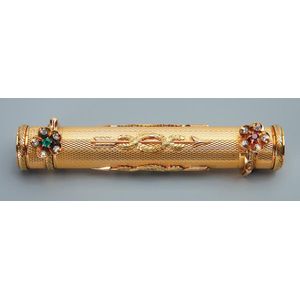Faberge double-end gold lipstick holder with gemstone flower thumbpieces
You must be a subscriber, and be logged in to view price and dealer details.
Subscribe Now to view actual auction price for this item
When you subscribe, you have the option of setting the currency in which to display prices to $Au, $US, $NZ or Stg.
- Circa - A Latin term meaning 'about', often used in the antique trade to give an approximate date for the piece, usually considered to be five years on either side of the circa year. Thus, circa 1900 means the piece was made about 1900, probably between 1895 and 1905. The expression is sometimes abbreviated to c.1900.
- Engine Turned - Engine turning is a decorative technique used on metal surfaces to create intricate curving or geometric pattern. The process involves cutting a series of lines into the surface of the metal using a rose engine or decoration lathe which rotates the metal as it cuts, allowing the operator to create a repeating pattern that covers the entire surface. The resulting surface has a shimmering, reflective quality that is often described as "engine turned." Where an engine turned item has been enamelled, the term used to describe the decoration is usually guilloche.
Engine turning was originally developed to decorate metal objects such as firearms, scientific instruments, and other metal objects that required precise and elegant design. - Floral Swag / Garland / Festoon - Floral swags are a decorative motif often used in the ornamentation of various objects, such as silverware, glassware, and furniture. The term "swag" refers to a garland or wreath of flowers, foliage, or other decorative elements, which is usually arranged in a loop or curve.
Floral swags can be found in a variety of decorative styles, from ornate Baroque and Rococo designs to more naturalistic Art Nouveau and Art Deco styles. They are often used to add a touch of elegance, refinement, or whimsy to an object, and can be seen on a range of items from chandeliers and candlesticks to picture frames and tea sets.
In the decoration of silver objects, floral swags are often used to accentuate the curves and lines of the piece, and to add visual interest to the surface. Similarly, on glass objects, floral swags may be used to frame or highlight a particular area of the object, or to add a touch of color and delicacy.
On furniture, floral swags can be found on a variety of pieces, from cabinets and armoires to chairs and sofas. They are often used to enhance the lines and curves of the furniture, and can be used to create a sense of movement and flow in the design.
Overall, floral swags are a versatile decorative element that can be adapted to a range of styles and applications, and have been used in the decoration of various objects throughout history. - Emeralds - Emeralds have been used in jewellery making for thousands of years, and are prized for their deep green colour, which is caused by the presence of chromium and vanadium in the mineral beryl. Because of their rare colour, emeralds are often more valuable than diamonds of a similar size and quality. In jewellery making, emeralds are typically cut into round or oval shapes to maximize their color and clarity. They are often set in gold or platinum and used as the centrepiece of a piece of jewellery, such as a ring or necklace. They can also be used in combination with other gems, such as diamonds, to create intricate and beautiful designs.
- Laurel Leaf - The use of the laurel leaf as a decorative element can be traced back to ancient Greece and Rome, where it was closely associated with victory and honour. In these cultures, the laurel was a sacred tree that was dedicated to the god Apollo and was believed to have protective and healing properties.
In ancient Greece, the laurel wreath was awarded to victors in athletic competitions, such as the Olympic Games, as a symbol of their achievement. The wreath was also associated with academic achievement, and was often worn by scholars and poets. The Greeks also used the laurel leaf as a symbol of victory in war, and it was often depicted in artwork alongside images of triumphant warriors and heroes.
The Romans continued this tradition, and the laurel wreath became a symbol of the highest military honor, the triumph, awarded to victorious generals. The wreath was also used to crown emperors and other important officials, and was often depicted in Roman art and architecture as a symbol of power and authority.
The laurel leaf is still used as a symbol of achievement, success, and excellence, and is frequently used in logos, emblems, and other branding materials. Its association with victory and honour has made it a popular choice for awards, medals, and other forms of recognition.
This item has been included into following indexes:
- Faberge (Russia) 119
Visually similar items

A sterling silver cigar piercer, Sheffield, maker AD

An Italian ruby bracelet, the front section of the ten strand bracelet set with four lines of ruby beads. 18ct yellow gold. Weight 57.86 grams. Length 20 cm. Width 3.4 cm. Marked Sun Day.

A Chinese pierced white jade plaque, Qing Dynasty, early 19th century, worked in high relief with deer amongst pine, the reverse side with a pagoda, mounted in a wooden stand. 7.8 cm high, 5.8 cm wide (height with stand 10.8 cm). Provenance: Franca Arena O

A pair of Victorian oak Gothic revival stools late 19th century with needlework covered tops height 32 cm, width 50 cm, depth 40 cm
